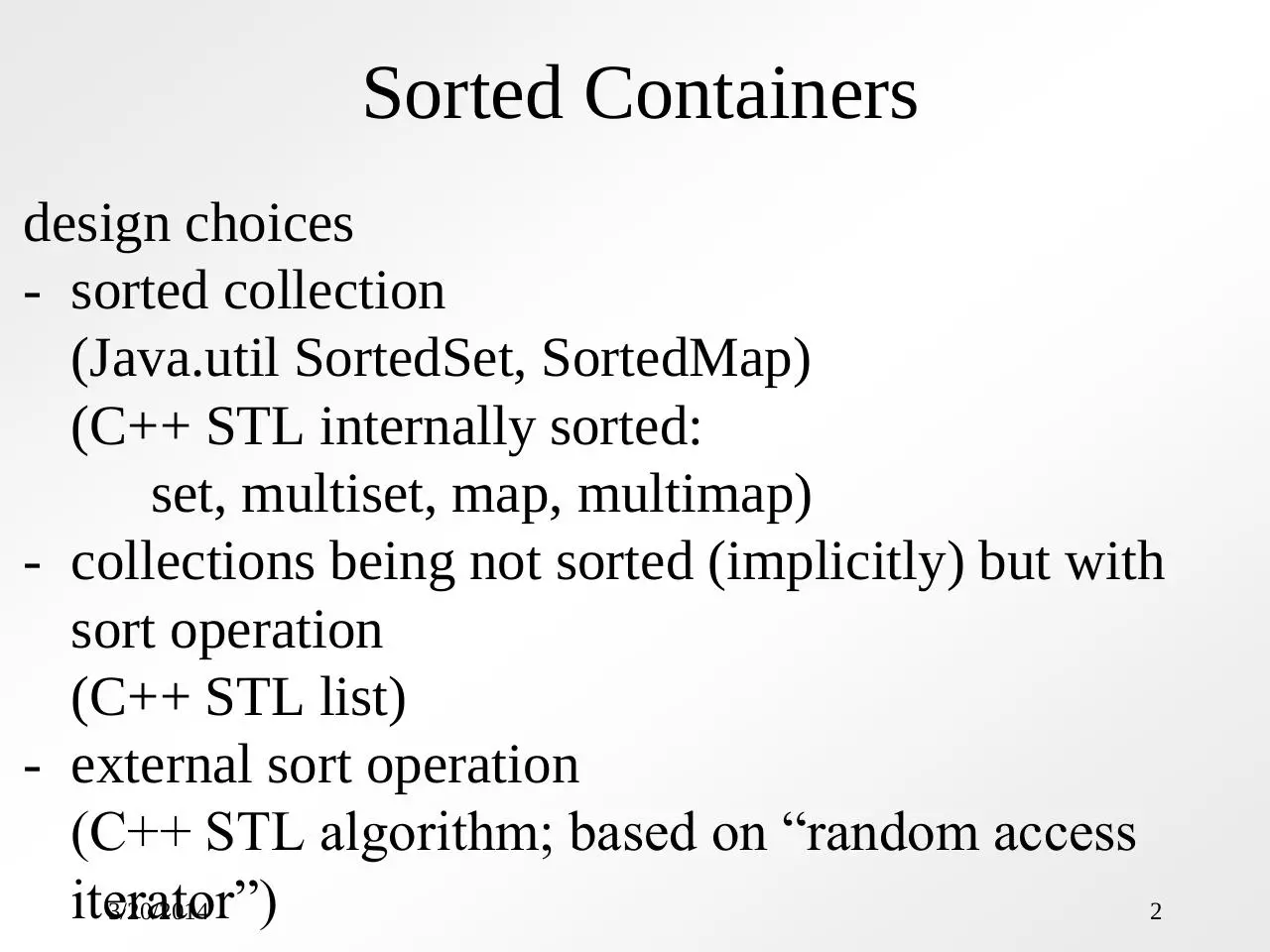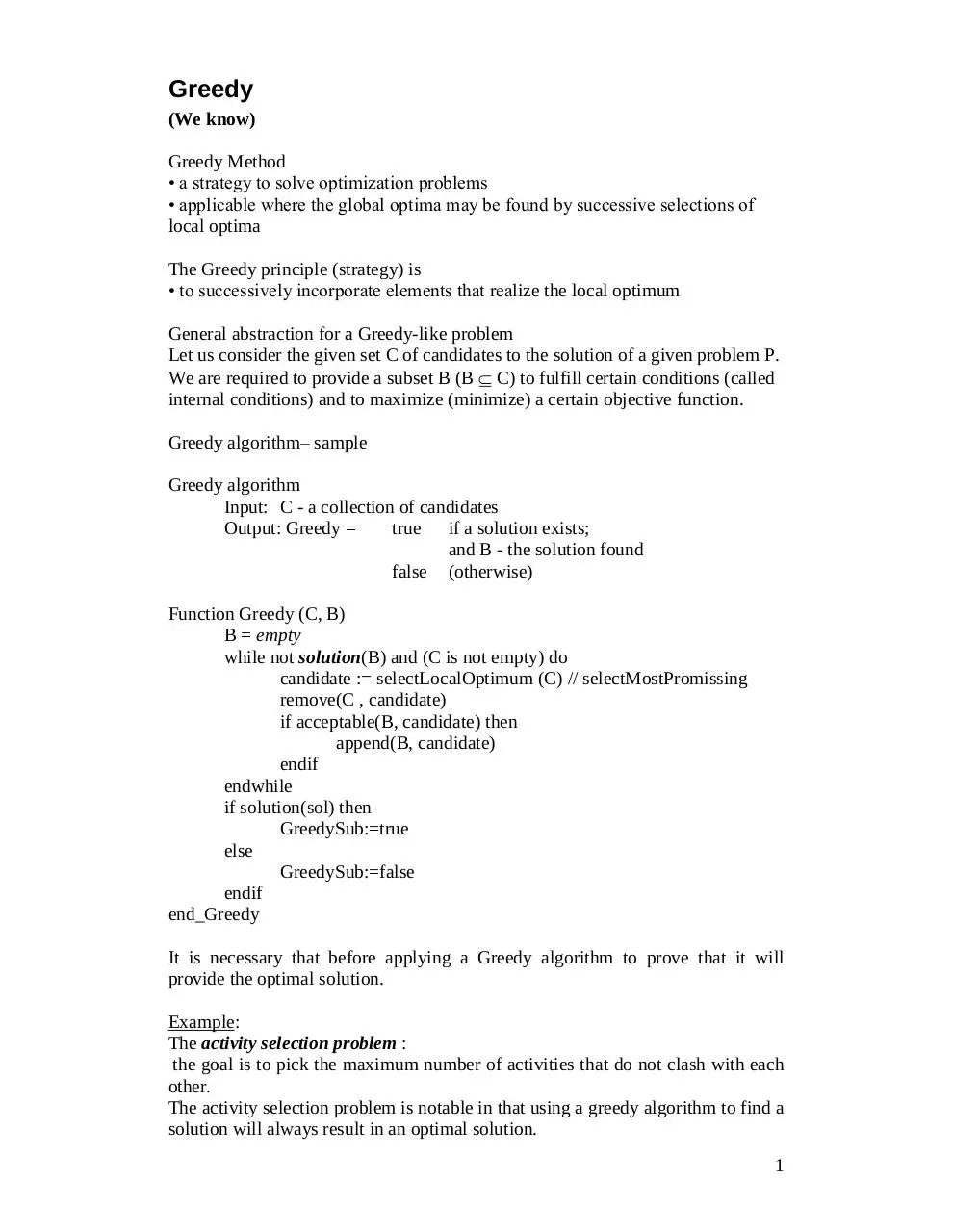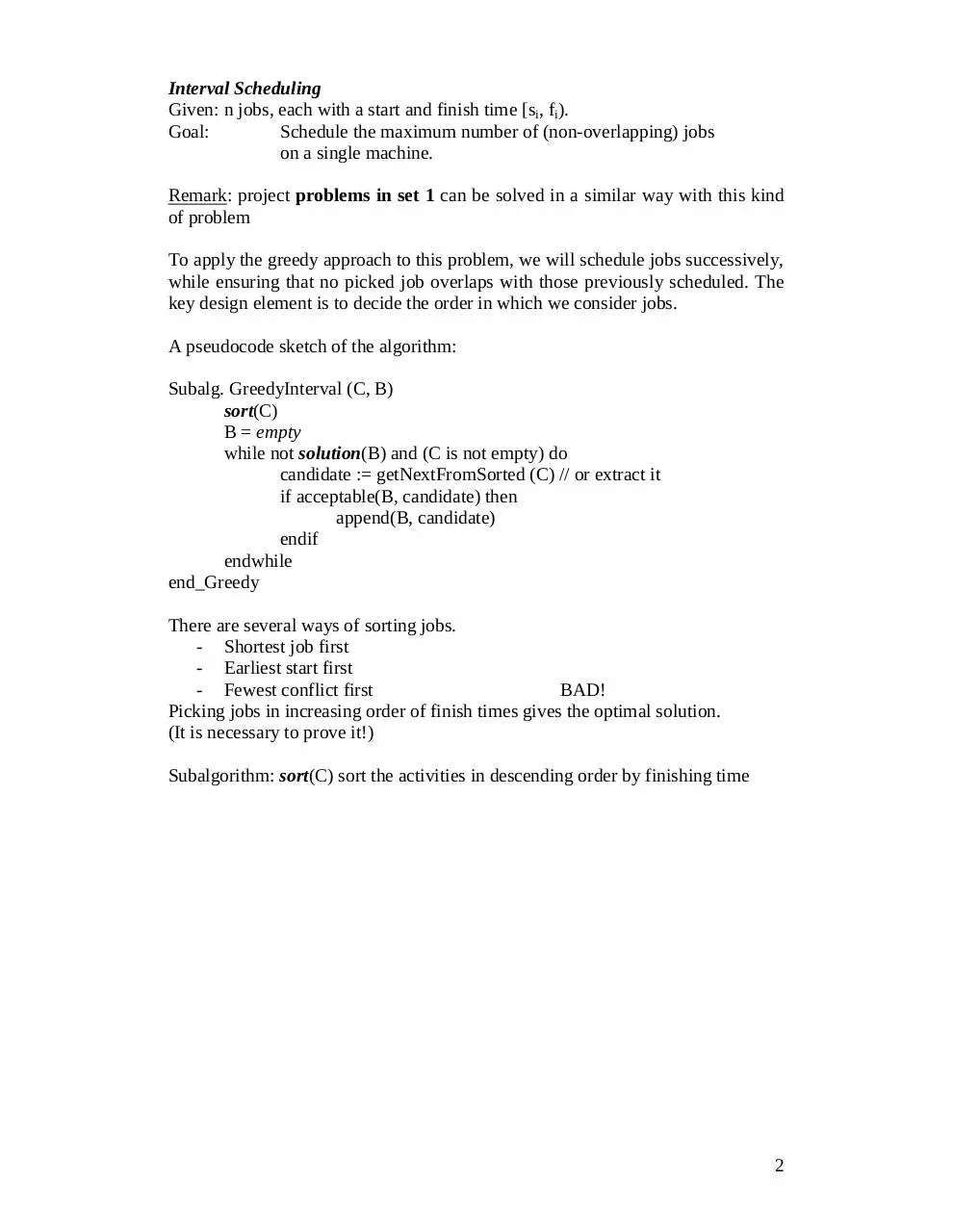Lecture04 (PDF)
File information
This PDF 1.4 document has been generated by PDFMerge! (http://www.pdfmerge.com) / iText® 5.5.0 ©2000-2013 iText Group NV (ONLINE PDF SERVICES; licensed version), and has been sent on pdf-archive.com on 24/03/2014 at 17:05, from IP address 188.24.x.x.
The current document download page has been viewed 998 times.
File size: 199.29 KB (6 pages).
Privacy: public file





File preview
Sorted Containers
Containers will be traversed in ascending element order
(Iterators)
by default:
• elements in the container are of type TCE
– less than comparable element
• sort by < operation
SortedList
SortedSet
SortedMap
SortedMultiMap
3/20/2014
1
Sorted Containers
design choices
- sorted collection
(Java.util SortedSet, SortedMap)
(C++ STL internally sorted:
set, multiset, map, multimap)
- collections being not sorted (implicitly) but with
sort operation
(C++ STL list)
- external sort operation
(C++ STL algorithm; based on “random access
iterator”)
3/20/2014
2
Priority Queue
Priority: element priority
• strict weak ordering
• priorities are not necessary distinct for all elements
Priority queue
• a container
• in which insertions/extractions are made following a fixed strategy
- each element has a priority associated with it
- each time - the extracted element has a maximum priority
max-priority-queue
(by default, for us)
… min-priority-queue
Remark: possible model (possible representation)
• each element e will be stored according to its priority ( container)
3/20/2014
3
Greedy
(We know)
Greedy Method
• a strategy to solve optimization problems
• applicable where the global optima may be found by successive selections of
local optima
The Greedy principle (strategy) is
• to successively incorporate elements that realize the local optimum
General abstraction for a Greedy-like problem
Let us consider the given set C of candidates to the solution of a given problem P.
We are required to provide a subset B (B C) to fulfill certain conditions (called
internal conditions) and to maximize (minimize) a certain objective function.
Greedy algorithm– sample
Greedy algorithm
Input: C - a collection of candidates
Output: Greedy =
true if a solution exists;
and B - the solution found
false (otherwise)
Function Greedy (C, B)
B = empty
while not solution(B) and (C is not empty) do
candidate := selectLocalOptimum (C) // selectMostPromissing
remove(C , candidate)
if acceptable(B, candidate) then
append(B, candidate)
endif
endwhile
if solution(sol) then
GreedySub:=true
else
GreedySub:=false
endif
end_Greedy
It is necessary that before applying a Greedy algorithm to prove that it will
provide the optimal solution.
Example:
The activity selection problem :
the goal is to pick the maximum number of activities that do not clash with each
other.
The activity selection problem is notable in that using a greedy algorithm to find a
solution will always result in an optimal solution.
1
Interval Scheduling
Given: n jobs, each with a start and finish time [si, fi).
Goal:
Schedule the maximum number of (non-overlapping) jobs
on a single machine.
Remark: project problems in set 1 can be solved in a similar way with this kind
of problem
To apply the greedy approach to this problem, we will schedule jobs successively,
while ensuring that no picked job overlaps with those previously scheduled. The
key design element is to decide the order in which we consider jobs.
A pseudocode sketch of the algorithm:
Subalg. GreedyInterval (C, B)
sort(C)
B = empty
while not solution(B) and (C is not empty) do
candidate := getNextFromSorted (C) // or extract it
if acceptable(B, candidate) then
append(B, candidate)
endif
endwhile
end_Greedy
There are several ways of sorting jobs.
- Shortest job first
- Earliest start first
- Fewest conflict first
BAD!
Picking jobs in increasing order of finish times gives the optimal solution.
(It is necessary to prove it!)
Subalgorithm: sort(C) sort the activities in descending order by finishing time
2
(What and) How to prove:
The “earliest finish time first” algorithm described above generates an optimal schedule
for the interval scheduling problem.
Consider an optimal solution S with at n jobs:
s1, s2, …, sn – being the jobs from S, ordered by their finish time.
(and they do not overlap)
Consider a solution G given by Greedy:
g1, g2, …– being the jobs from G, ordered by their finish time
(we didn’t specify the number of jobs in G)
(G <= picking jobs in increasing order of finish times, and not overlapping)
We prove by induction on k that P(k):
(For any k=1,n : )
P(k) P1(k): it exists gk greedy algorithm schedules at least k jobs
P2(k): gk finishes earlier or in the same time with job sk
And because: last finishing job in G from 1,..,k is gk
And last finishing job in S is sk
the first k jobs in G (scheduled by greedy algorithm) finish no
later than the first k jobs in the optimal solution S.
Remark:
for any k=1,..,n means also that k<=n.
there are at least k jobs in solution
We now prove the claim:
Base case:
P(1) P1(1)
Because there are at least k jobs in solution => exist g1
(We can’t pick a job only if there are no jobs )
P2(1)
Greedy choses the first ending job => g1 finishes earlier or at the same with s1
Inductive step:
P(k)=>P(k+1)
(only if k+1<=n)
What we know:
P(k) => job gk finishes earlier or in the same time with job sk
let sk+1 – the next job in S
sk+1 starts after sk ends
sk finishes after or at the same time with gk <= P(k)
it exists an nonoverlapping job that starts after gk
=> Greedy (can) choose a job gk+1
=> greedy algorithm schedules at least k+1 jobs P1(k)
sk+1 finishes after sk that finishes in the same time or after gk
sk+1 was not among of g1…gk
In the set of jobs from which Greedy chooses the first finishing job, there is also
job sk+1; Greedy choses the first finishing job from here
gk+1 finishes at the same time or earlier than sk+1 P2(k)
(This completes the proof of the claim.)
3
Download Lecture04
Lecture04.pdf (PDF, 199.29 KB)
Download PDF
Share this file on social networks
Link to this page
Permanent link
Use the permanent link to the download page to share your document on Facebook, Twitter, LinkedIn, or directly with a contact by e-Mail, Messenger, Whatsapp, Line..
Short link
Use the short link to share your document on Twitter or by text message (SMS)
HTML Code
Copy the following HTML code to share your document on a Website or Blog
QR Code to this page

This file has been shared publicly by a user of PDF Archive.
Document ID: 0000153687.